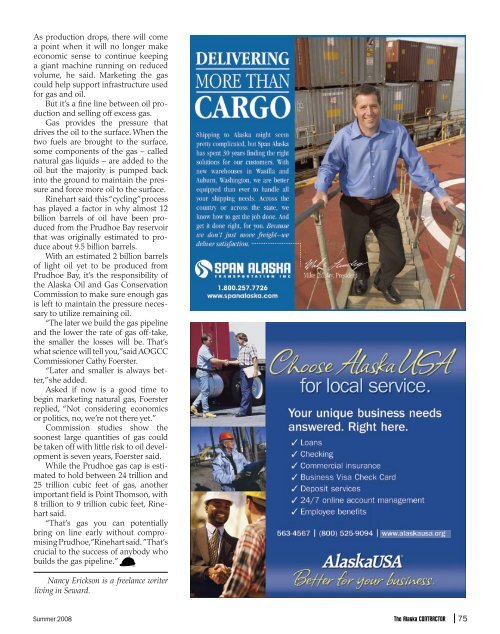The Alaska Contractor - Summer 2008
The Alaska Contractor - Summer 2008
The Alaska Contractor - Summer 2008
Create successful ePaper yourself
Turn your PDF publications into a flip-book with our unique Google optimized e-Paper software.
As production drops, there will come<br />
a point when it will no longer make<br />
economic sense to continue keeping<br />
a giant machine running on reduced<br />
volume, he said. Marketing the gas<br />
could help support infrastructure used<br />
for gas and oil.<br />
But it’s a fine line between oil production<br />
and selling off excess gas.<br />
Gas provides the pressure that<br />
drives the oil to the surface. When the<br />
two fuels are brought to the surface,<br />
some components of the gas – called<br />
natural gas liquids – are added to the<br />
oil but the majority is pumped back<br />
into the ground to maintain the pressure<br />
and force more oil to the surface.<br />
Rinehart said this “cycling” process<br />
has played a factor in why almost 12<br />
billion barrels of oil have been produced<br />
from the Prudhoe Bay reservoir<br />
that was originally estimated to produce<br />
about 9.5 billion barrels.<br />
With an estimated 2 billion barrels<br />
of light oil yet to be produced from<br />
Prudhoe Bay, it’s the responsibility of<br />
the <strong>Alaska</strong> Oil and Gas Conservation<br />
Commission to make sure enough gas<br />
is left to maintain the pressure necessary<br />
to utilize remaining oil.<br />
“<strong>The</strong> later we build the gas pipeline<br />
and the lower the rate of gas off-take,<br />
the smaller the losses will be. That’s<br />
what science will tell you,” said AOGCC<br />
Commissioner Cathy Foerster.<br />
“Later and smaller is always better,”<br />
she added.<br />
Asked if now is a good time to<br />
begin marketing natural gas, Foerster<br />
replied, “Not considering economics<br />
or politics, no, we’re not there yet.”<br />
Commission studies show the<br />
soonest large quantities of gas could<br />
be taken off with little risk to oil development<br />
is seven years, Foerster said.<br />
While the Prudhoe gas cap is estimated<br />
to hold between 24 trillion and<br />
25 trillion cubic feet of gas, another<br />
important field is Point Thomson, with<br />
8 trillion to 9 trillion cubic feet, Rinehart<br />
said.<br />
“That’s gas you can potentially<br />
bring on line early without compromising<br />
Prudhoe,” Rinehart said. ”That’s<br />
crucial to the success of anybody who<br />
builds the gas pipeline.”<br />
Nancy Erickson is a freelance writer<br />
living in Seward.
















